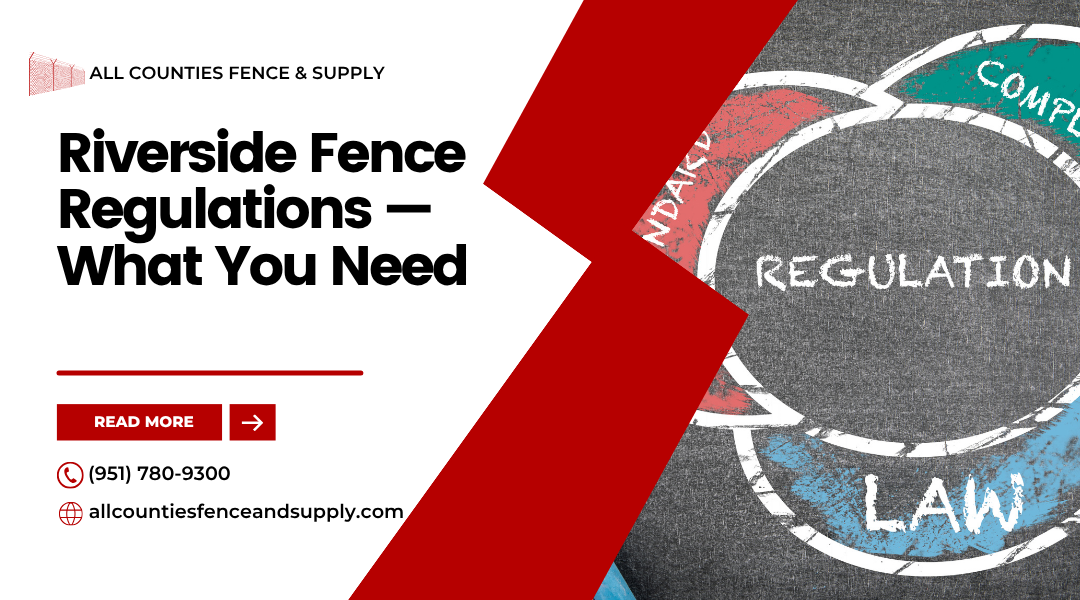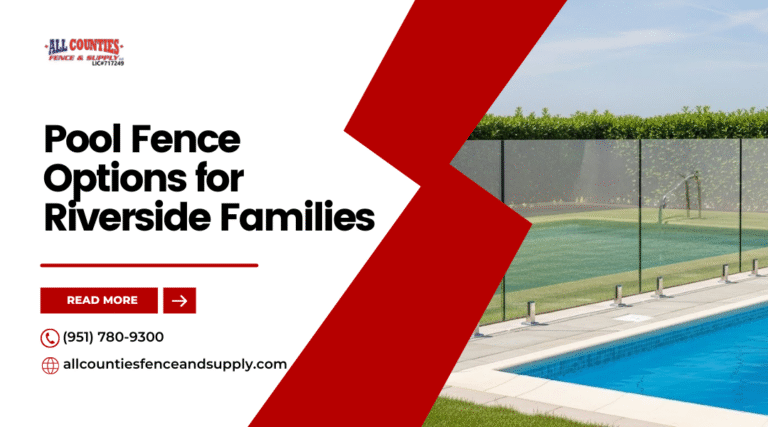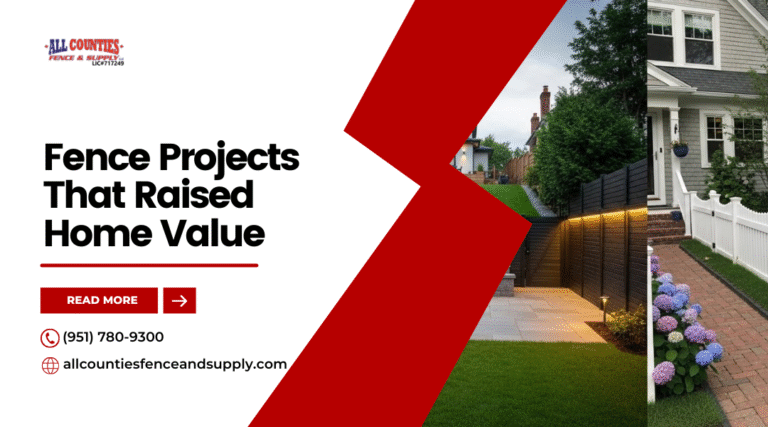When considering a new fence for your property in Riverside, California, understanding local permits and regulations is essential. Knowing the specific requirements can save you time and help you avoid costly mistakes. Each city has its own rules about fence height, materials, and placement, so it’s crucial to research before starting your project.
Working with a knowledgeable contractor like All Counties Fence & Supply ensures you follow all local guidelines. From residential wood fences to commercial chain-link options, knowing what is permitted can guide your choices. Your dream fence should not only enhance your property but also comply with city regulations to avoid potential fines or removal.
As you explore your fencing options, keep these regulations in mind. With the right information, you can confidently move forward with a project that fits your needs and meets legal standards. Get ready to transform your space while staying informed about what is required in Riverside.
Understanding Fence Permits in Riverside, California
When planning a fence installation in Riverside, understanding permit requirements is crucial. This knowledge can save you time and ensure your project complies with local regulations. Here’s what you need to know about fence permits.
When Is a Fence Permit Required?
In Riverside, a permit is generally required for certain types of fences. If your fence will exceed 6 feet in height, you must obtain a permit. Additionally, if you’re installing a fence in a front yard, the height restriction is usually limited to 4 feet without a permit.
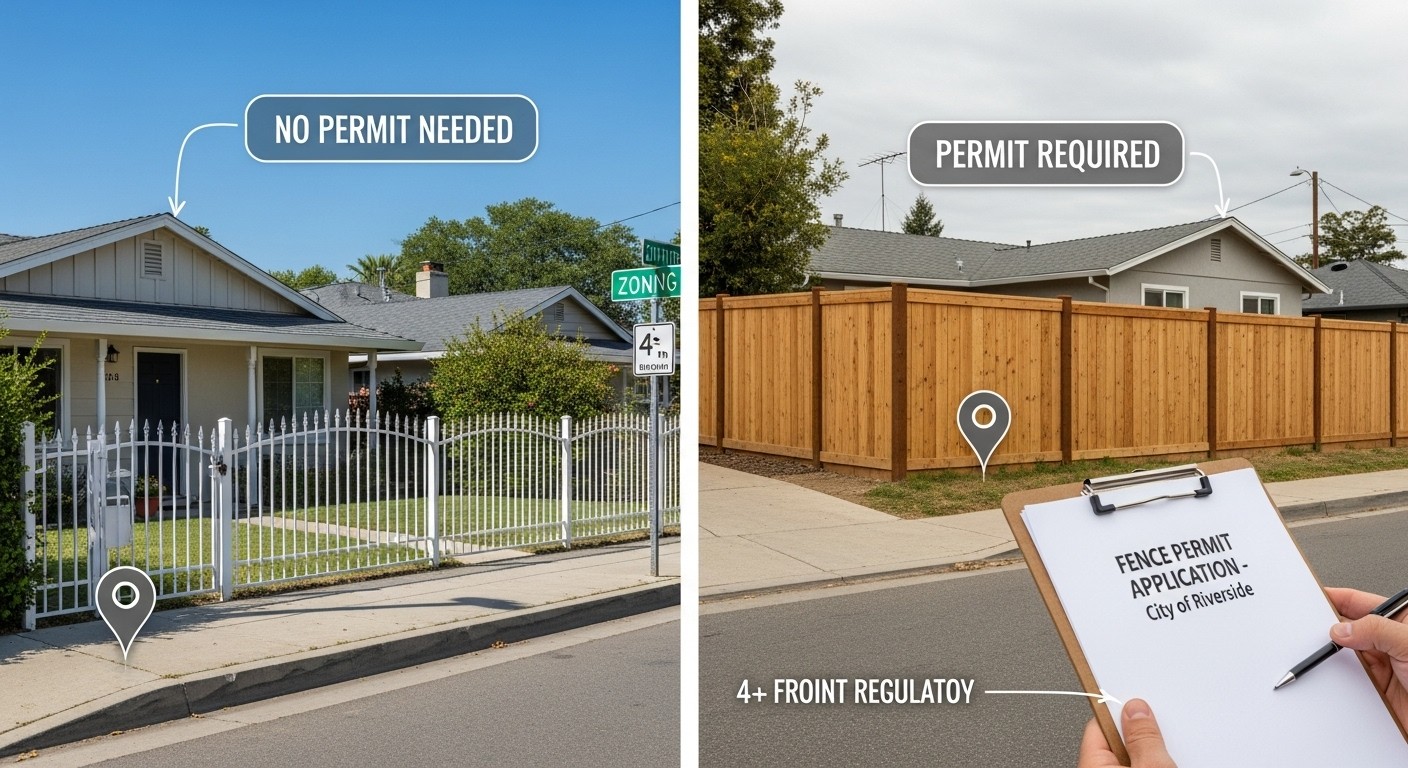
It’s important to check specific zoning regulations for your area. Some neighborhoods may have unique rules based on local ordinances. Always confirm these details before starting your project to avoid potential fines.
Role of the Riverside Building Department
The Riverside Building Department plays a key role in the permit process. Their main function is to ensure all installations meet local building codes and safety standards. This oversight protects you and your property.
When you apply for a fence permit, the Building Department reviews your plans. They check for compliance with zoning laws, including height and material restrictions. If your plans are approved, you’ll receive a building permit, allowing you to start your installation legally.
Common Permit Requirements for Fence Installation
Before installing a fence, it’s essential to understand common permit requirements. Typically, you will need to submit a site plan showing where the fence will be placed. This plan should include property lines and neighboring structures.
Additionally, you may need to provide details about materials and fence height. Payment of any applicable fees will also be necessary. To make the process smoother, consider contacting the Riverside Building Department in advance for guidance. Having all your documentation ready can help expedite the permit approval process.
Key Fence Regulations and Zoning Laws
Understanding fence regulations in Riverside, California is essential for homeowners. Local zoning laws dictate what you can build, how tall your fence can be, and special requirements for security and privacy.
Understanding Local Zoning Laws
Local zoning laws play a crucial role in determining what types of fences you can build. The City of Riverside has specific guidelines that you must follow. These laws often vary based on your neighborhood.
Before starting any project, check with the local planning department. They can help you understand any restrictions that apply to your property. This ensures your fence complies with community standards and avoids potential legal issues.
Maximum Fence Height and Visibility Standards
In Riverside, there are height restrictions for fences. Typically, front yard fences cannot exceed 4 feet. For backyards, the maximum height is often 6 feet.
Visibility is another important factor. Fences near intersections or driveways must not obstruct views. This protects both motorists and pedestrians, promoting safety in your neighborhood. Always verify the specific standards that apply to your area.
Regulations for Security and Privacy Fences
If you plan to build a security or privacy fence, you need to follow additional regulations. These fences often have stricter requirements regarding materials and construction methods.
For example, tall privacy fences usually require a building permit. It is important to build with durable materials, such as wood or vinyl. Security fences may also need to meet local safety standards to discourage trespassing and enhance protection.
Consult the local zoning board to ensure your security fence meets all guidelines. This will help you avoid issues after construction begins.
Navigating City, County, and HOA Rules
When planning to build a fence in Riverside, it’s essential to understand the regulations set by the city, county, and any homeowners associations (HOAs) in your area. Each of these entities has its own requirements that you must follow to ensure your project is compliant.
Differences Between City and County Building Requirements
City and county building requirements can differ significantly. The City of Riverside has specific zoning laws and guidelines that need to be followed. For example, the city may have rules about fence heights, materials, and placement near property lines.
In Riverside County, rules can be broader or more lenient, depending on the unincorporated area where you live. Before starting your project, check both the city’s building department and the county’s regulations. Make sure to obtain the necessary permits, as failure to do so could lead to fines or removal of the fence.
Working with Homeowners Associations
If you live in a community governed by a homeowners association (HOA), you should familiarize yourself with its rules regarding fences. Most HOAs have specific guidelines on what types of fences are allowed, their height, and how they should look.
You may need to submit plans for approval before beginning construction. It’s important to communicate openly with your HOA to avoid any surprises. Understand that HOA regulations can be stricter than city or county rules, so review them carefully to ensure compliance.
Important Contacts: County Building Departments
To navigate the building process successfully, you should know who to contact. The Riverside County Building Department is a key resource for understanding county regulations. They can provide details on permits and inspections needed for fence construction.
For city-specific requirements, reach out to the City of Riverside Building Department. They can assist you with zoning laws and any city-specific permits. Having these contacts will help ensure that your fence project runs smoothly and stays within legal requirements.
Property Line Issues and Fence Construction Guidelines
When planning to build a fence, understanding property lines and regulations is crucial. You need to know where your property ends and your neighbor’s begins. Additionally, shared fences may require agreements between neighbors to avoid disputes.
Determining Accurate Property Lines
Determining the exact boundaries of your property is essential before starting any construction. If you are unsure where your property line lies, consider hiring a professional surveyor. They can provide precise measurements and mark the boundary clearly.
Be aware that local building officials may require a survey for fence permits. Knowing the exact property line helps you avoid encroaching on your neighbor’s land. This can prevent disputes and potential legal issues in the future.
Always check local zoning laws, as they may affect the placement of your fence. Pay attention to setbacks and easements that could impact where you can build.
Shared Fences and Neighbor Agreements
When constructing a fence on or near your property line, it’s wise to discuss it with your neighbors. If the fence is on the boundary, both parties may be responsible for costs and maintenance. This is part of California’s “Good Neighbor Fence” law.
Secure a written agreement to outline responsibilities, including construction and upkeep. This approach promotes goodwill and can prevent future disagreements.
If a dispute arises, consult with your local building official for guidance. They can help clarify rules regarding shared fences and property lines. Having a clear understanding and agreement sets the stage for a smooth fencing project.
Material and Installation Considerations for Riverside Fences
When planning your fence in Riverside, it’s essential to consider the type of materials you will use and the specific installation requirements. Choosing the right materials affects durability, maintenance, and overall appearance. Additionally, following local regulations ensures safety and compliance.
Choosing Between Wood, Masonry, and Concrete Fences
Wood is popular due to its natural appearance and affordability. It provides privacy and can be customized easily. However, it requires regular maintenance and may not last as long as other materials in the Riverside climate.
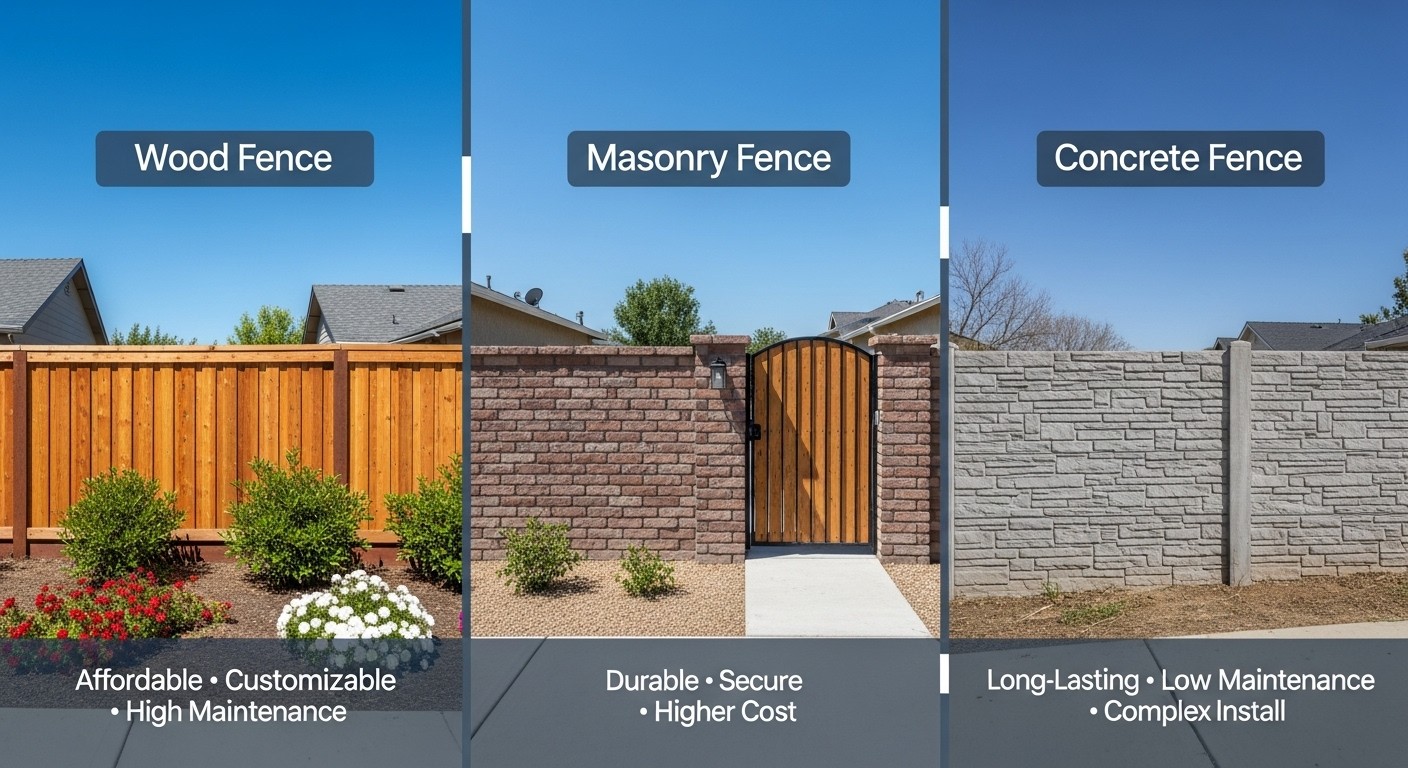
Masonry fences, consisting of brick or stone, offer durability and low maintenance. They are strong and provide excellent security but can be costly and require professional installation.
Concrete fences are another sturdy option. They are long-lasting and can mimic other materials like wood or masonry. However, installation can be complex, as concrete needs time to cure properly.
Plumbing and Electrical Work Regulations
Before starting your fence project, check for plumbing and electrical lines on your property. Local regulations often dictate how close your fence can be to these utilities.
You may require permits for digging or installing posts. Ensure you contact utility companies to mark lines before you start. This step prevents damage to underground utilities and keeps you safe while working.
Best Practices for Fence Installation
Start by checking local regulations, including height restrictions and property line boundaries. You may need a permit depending on your fence type. Always consult the permit guidelines in Riverside for specific requirements.
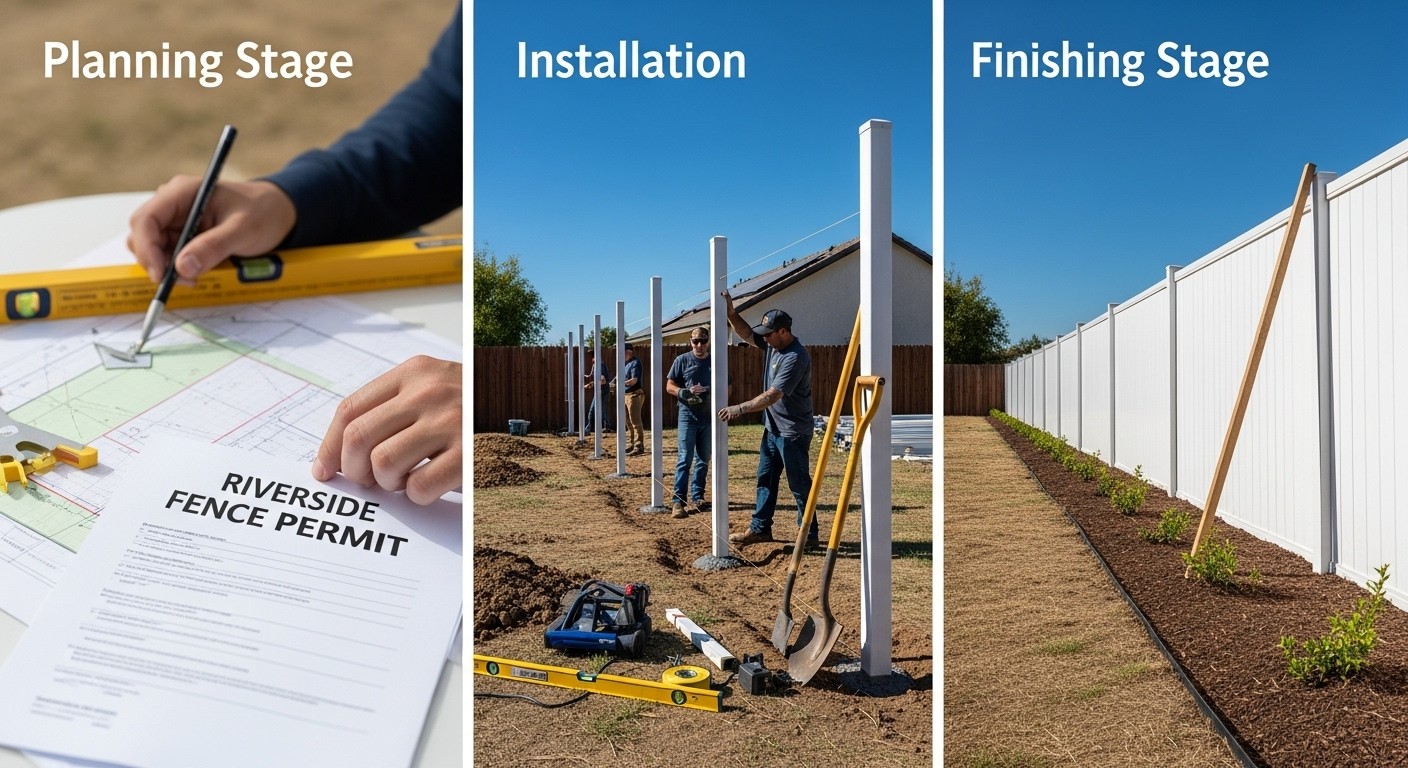
Use quality materials for installation. Proper preparation, like leveling the ground and securing posts, is important for stability.
Lastly, consider weather conditions. Plan your installation during dry seasons to avoid complications with wet soil, which could affect post stability. Taking these steps will help ensure that your fence is sturdy and compliant with regulations.
Why Hire All Counties Fence & Supply as Your Riverside Fence Contractor
Choosing the right fence contractor is essential for your fencing project. All Counties Fence & Supply offers a blend of experience, professionalism, and dedication, making it a great choice for your needs in Riverside, California.
Benefits of Professional Fence Installation
When you hire All Counties Fence & Supply, you benefit from their extensive experience in fence installation. They have been serving Riverside County since 1978, providing quality workmanship and materials.
A professional installation ensures your fence meets local regulations, which can vary widely. This compliance helps you avoid potential fines or the need for costly repairs.
Additionally, skilled contractors can help you select the best materials for your property. They understand which types of fencing will last longest and best match your home’s style, ensuring your investment is worthwhile.
Working with Licensed Contractors
Working with licensed contractors like All Counties Fence & Supply gives you peace of mind. They hold the necessary licenses to operate in California, ensuring they follow all legal requirements.
Licensed contractors are also knowledgeable about local codes and permits. This expertise is important when building fences that comply with city regulations in Riverside.
By choosing a licensed company, you gain access to warranties on both labor and materials. This added protection means if a mistake occurs, it will be addressed at no extra cost to you. You can trust that your fence project will be handled professionally from start to finish.

